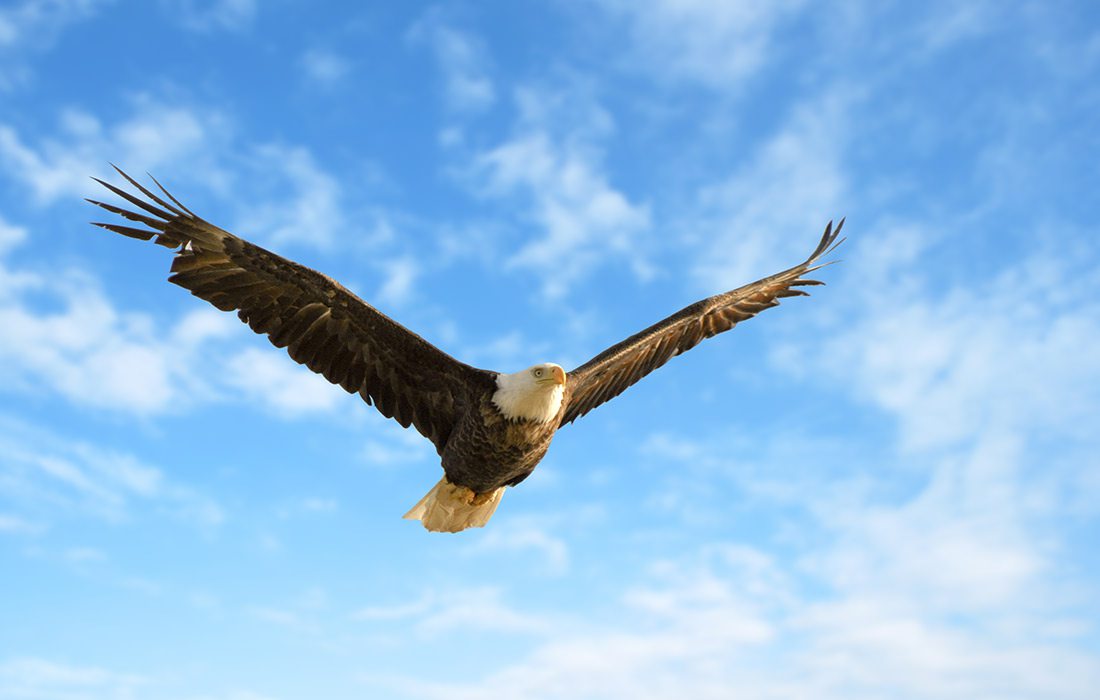Outdoors
Where to See Bald Eagles in Missouri This Winter Season
The U.S. national emblem, the bald eagle, is making its annual commute to our state this month. Read on to learn more about these birds and where you might discover them in Springfield, MO.
By Reese Radmacher, additional reporting by Katie Pollock Estes
Jan 2025

With their piercing stare and brawny build, it’s no surprise bald
eagles were chosen to be the national emblem by the Second Continental
Congress in 1782. The majestic creatures symbolize wisdom, power and
freedom, and their build and size reflect this well. Their outward
appearance is just one of their many admirable qualities. Francis
Skalicky, media specialist for the southwest region of the Missouri
Department of Conservation, says the sizable birds can have wingspans of
up to eight feet, a flight speed range of 20 to 40 mph and eyesight
that is five to six times sharper than that of humans. Furthermore,
these versatile birds can swim and can dive at speeds up to 100 mph.
So,
how did our nation’s emblem become endangered? According to Skalicky,
in conjunction with illegal hunting of the eagles based on the
assumption they were predators of livestock and aquatic wildlife, the
central problem resided in the use of a pesticide known as DDT, which
effectively controlled insects but had a detrimental effect on bird reproduction—resulting in eggshells that were far too soft.
Now,
bald eagles have made a comeback. The birds are still considered a
species of concern in Missouri, but they are no longer classified as
endangered, either here or federally. “It’s one of the great
conservation success stories of Missouri and of the nation, really,”
Skalicky says.
As a state with open water, or unfrozen water, Missouri is an especially appealing place for bald eagles in the winter. “If you do know where an eagle is actually nesting, keep your distance,” Skalicky says. “Let them nest. Let them raise their young. We do like having bald eagles around. One way to keep them around is if they have successful reproduction.” You have countless opportunities throughout winter to spot this remarkable species by visiting these places around southwest Missouri where bald eagles have been known to live or fly through.
Eagle Days
Where: Lake Springfield Boathouse
When: January 18, 9 a.m.–5 p.m.; January 19, noon–4:30 p.m.
Why: Eagles and other birds use Lake Springfield during migration, and guides teach you all about them. After the presentation, hike around to look for eagles. You can use your own equipment (binoculars, etc.) or use some provided by Lake Springfield Boathouse.
Eagles of North America
Where: Dogwood Canyon Nature Park (Lampe)
When: January 5 and 11, 1–2 p.m.
Why: Take a break from wild eagle watching and pop into an educational event. Dickerson Park Zoo presenters will be on hand to teach guests about bald eagles and other birds of prey. Plus you can see a bald eagle up close.
Go Solo
Where: Stockton Lake or Table Rock Lake
When: Now through February
Why: If you prefer to search on your own, Stockton Lake and Table Rock Lake are excellent places to go. Eagles love to nest and hunt near open water. Find a quiet place on the shore, or take a boat out early in the morning.
River of Life Farm
As the best wild rainbow trout fishery in the Midwest and one of America’s 100 best trout streams, River of Life Farm (1746 River of Life Drive, Dora, 417-261-7777) attracts plenty of tourists and bald eagles alike thanks to The North Fork of the White River. Myron McKee, owner of the establishment, says guests canoeing along the river occasionally notice eagles perched in a tree watching them pass, or they will soar steadily in front of canoes, as if leading the way. The river has 4,000 fish per mile, so McKee says the eagles have plenty to chew on. The farm is inhabited by two pairs of year-round resident bald eagles and two nests. To better grasp the size and complexity of bald eagle nests, Skalicky says they “look like a Volkswagen Beetle that’s been turned upside down in a tree.” For a different view of the North Fork River and additional opportunity to spot an eagle, take the ¾-mile hike to Inspiration Point.
Lakes, Rivers, and State Parks
Annually every January, Skalicky says conservation agents count bald eagle populations county by county, then submit their findings to the U.S. Fish and Wildlife Service. Through this, agents found Barry County to be an area with a recurring higher count—likely a result of Roaring River and the western part of Table Rock Lake’s location in the county. Rivers and lakes along with state parks such as Mooring River and Bennett Springs are other locales Skalicky recommends. “Bald eagles will be where bald eagles wanna be—like I say, they’re wild animals,” Skalicky says. “If you know of roads that go along rivers, it’s just one of those things: When you’re driving, keep your eyes open.”












